Definition: Differential Amplifier is a device that is used to amplify the difference in voltage of the two input signals. Differential Amplifier is an important building block in integrated circuits of analog system.
It typically forms input stages of operational amplifiers. In simple words, we can say It is a device that amplifies the difference of 2 input signals.
Let’s have a look at the below-shown diagram where an operational amplifier is used as a differential amplifier:
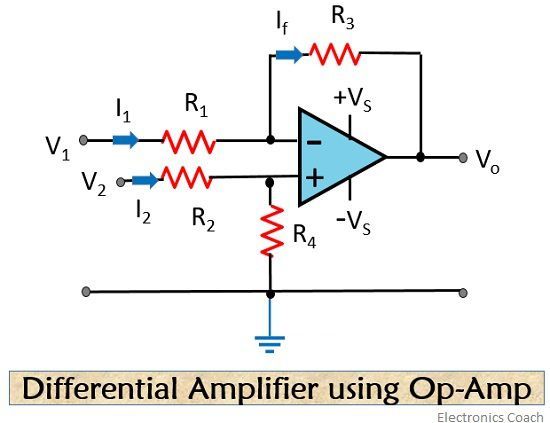
![]()
Here, the voltage difference present at the inverting and non-inverting terminal gets amplified and thus an amplified output is received. Because of input configuration, all op-amps are considered to be differential amplifiers.
When two inputs are applied at the two terminals the voltage difference produced resultantly will be proportional to the difference of the two applied input signals. Differential amplifier behaves as subtractor circuit, that basically subtracts the two input signal. The differential amplifier can be constructed by making use of BJTs and FETs.
Circuit of Differential Amplifier
As we can see in the circuit diagram there are two inputs and two outputs are used. Here, two separate transistor Q1 and Q2 are employed so as to apply separate inputs at the base of both the transistor.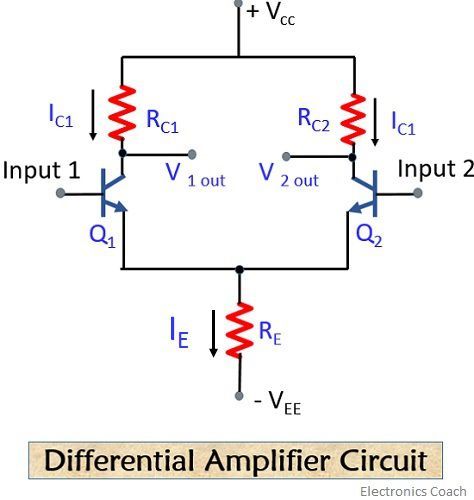
The two separate transistors possess similar characteristics ideally. Common emitter resistor RE, common positive supply VCC and common negative supply VEE is shared by both the transistors.
Now, the thing that comes to our mind is how can we apply signals at the input and get the output.
There are mainly four configurations:
- Dual Input Balanced Output- In this configuration two inputs are given an output is taken from both the transistors.
- Dual Input Unbalanced Output- The input is given to both the transistors but the output is taken from a single transistor.
- Single Input Balanced Output- Here, by providing single input we take the output from two separate transistors.
- Single Input Unbalance Output- It is a type of configuration in which a single input is given an output is taken from only a single transistor.
Working of Differential Amplifier
Let us see the First case where
A signal is applied at the base of transistor Q1 and no any signal is applied at the base of transistor Q2.
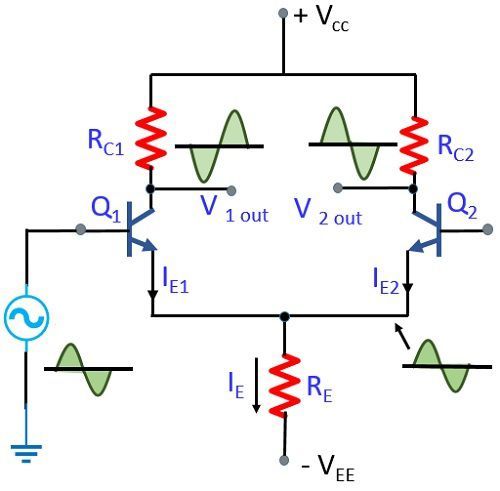
Here, Q1 acts in two ways: firstly, as common emitter amplifier, by which applied input at Q1 will provide an amplified inverted signal at output 1.
Secondly, as common collector amplifier, in which the signal appears at the emitter of Q1 which is in phase with the input and slightly smaller.
So, the input signal at the base of Q1 drives the transistor i.e., Q1 turns ON by the positive input signal. The voltage drop across RC1 will be more resulting the collector of Q1 to be less positive.
When the input signal is negative, transistor Q1 will get OFF resulting in less voltage drop across RC1 causing collector of Q1 to be more positive.
In this way, an inverted output appears at the collector of Q1 by applying the signal at input 1.
At the time when Q1 gets ON by positive half of input, the current through RE will increase as we know IC ≈ IE. So, the voltage drop at RE will be more thus causing the emitters of both the transistors to go in the positive direction.
This Q2 emitter positive will cause the base of Q2 to be negative. This negative half will cause less current in Q2. Resultantly voltage drop at RC2 will also be less thus the collector goes in the positive direction.
In this way, we will have a non-inverting output at the collector of Q2 for positive input at the base of Q1.
Now, moving further to our Second case-
Suppose the signal is now applied to the base of transistor Q2 and transistor Q1 is grounded.
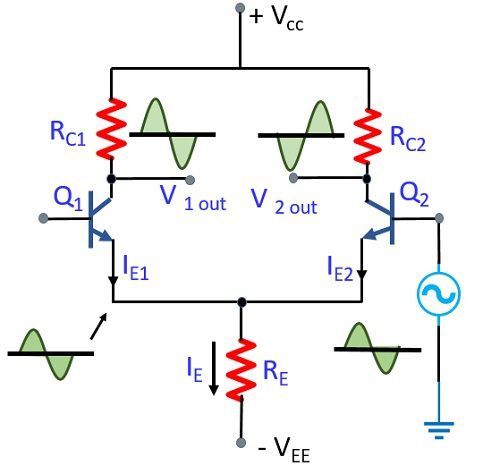
So, in this condition the above-discussed case will get interchanged i.e., now Q2 will behave as common emitter and common amplifier and Q1 will act as a common base amplifier.
Hence, an inverted and amplified output will be received at the output of Q1 and at the output of Q2 we will have a non-inverted amplified output.
What are Common-Mode Signals?
In a differential amplifier, the voltage generated at the output is proportional to the difference of the two input signals. So, when the two applied inputs are equal i.e., there is no difference between the two input voltage the resulting output voltage will be 0.
But practically when two similar inputs are applied at both the input terminal, the output does not exactly equal to 0.
The output in case of common mode signal is of the order of several 100 µV.
Important Key terms
- Voltage Gain: When we talk about common mode gain

Here, Vc is the value of common input applied at both the input terminal and Vo is the output signal.
- CMMR: CMMR stands for Common Mode Rejection Ratio, it is given as the ratio of differential mode gain to the common mode gain.

In dB, 
For an ideal amplifier CMMR should be practically infinite but in actual practice, it is not so and has a finite value.
It is defined as the ratio of the desired signal to the undesired signal. The larger the CMMR the better is the amplifier.
Differential amplifier provides excellent bias stability because of use of emitter current bias.
Wheatstone Bridge Differential Amplifier
The differential amplifier can also be a differential voltage comparator where it compares one input signal with the other.
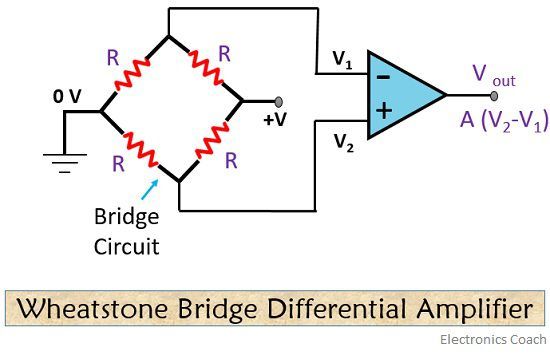
Suppose we connect one input to a fixed reference voltage and the other to a Light Dependent Resistor or to a thermistor. We can detect a low or high level of light.
This is so because now the output voltage will be a linear function of changes in the bridge circuit.
Advantages of Differential Amplifier
- Noise immunity: When we use a differential amplifier, it responds to the only difference signal between input terminals and ignores all common mode signals such as noise pick-up and ground voltages.
- Drift Immunity: One major problem that arises in amplifiers is the change in voltage levels or value by the effect of temperature. These changes occur slowly and are known as drift. Differential amplifiers exhibit tremendous ability to eliminate the problem of drift.
The construction of Differential Amplifier is used in all those circuits where low drift is very important. Such as stages of Oscilloscope and electronics voltmeter.
Rahmtalla says
Thank u for this useful information, more successful